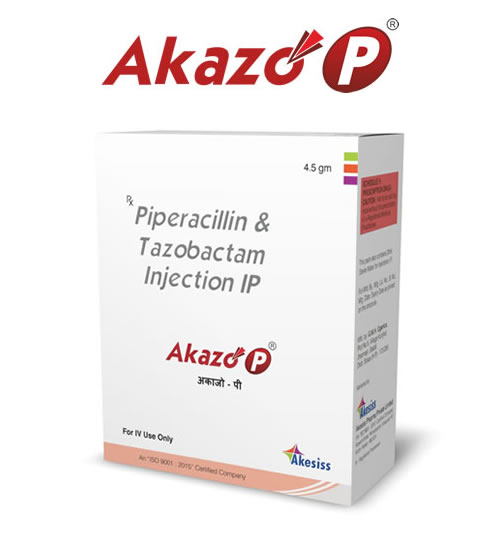COMPOSITION:
Each Vial contains:
Piperacillin Sodium USP eq. to Piperacillin …….. 4 gm
Tazobactum Sodium eq. to Tazobactum ………… 500mg
DESCRIPTION:
Akazo P (piperacillin and tazobactam for injection) is an injectable antibacterial combination
product consisting of the semisynthetic antibiotic piperacillin sodium and the β-lactamase inhibitor tazobactam sodium for intravenous administration.
Pharmacology:
Piperacillin, a broad spectrum, semisynthetic penicillin active against many Gram-positive and Gram-negative aerobic and anaerobic bacteria, exerts bactericidal activity by inhibition of both septum and cell wall synthesis. Tazobactam, a triazolylmethyl penicillanic acid sulfone, is a potent inhibitor of many β-lactamases, including the plasmid and chromosomally mediated enzymes that commonly cause resistance to penicillins. The presence of tazobactam in the Akazo P formulation enhances and extends the antibiotic spectrum of piperacillin to include many β-lactamase producing bacteria normally resistant to it. Thus, Akazo P combines the properties of a broad-spectrum antibiotic and a β-lactamase inhibitor.
Indication:
AKAZO P is indicated for the treatment of the following systemic and/or local bacterial infections in which susceptible organisms have been detected or are suspected:
1. Lower respiratory tract infections
2. Urinary tract infections (complicated and uncomplicated)
3. Intra-abdominal infections
4. Skin and skin structure infections
5. Bacterial septicaemia
6. Gynaecological infections
7. Bacterial infections in neutropenic patients.
8. Bone and joint infections
9. Polymicrobic infections: AKAZO P is indicated for polymicrobic infections including those where aerobic and anaerobic organisms are suspected (intra-abdominal, skin and skin structure, upper and lower respiratory tract, gynaecological).
Contraindications:
Akazo P is contraindicated in patients with a history of allergic reactions to any of the penicillins, cephalosporins, or β-lactamase inhibitors
Precautions:
Bleeding manifestations have occurred in some patients receiving β-lactam antibiotics, including piperacillin. These reactions have sometimes been associated with abnormalities of coagulation tests such as clotting time, platelet aggregation and prothrombin time, and are more likely to occur in patients with renal failure. If bleeding manifestations occur, AKAZO P (piperacillin and tazobactam for injection) should be discontinued and appropriate therapy instituted.
Dosage and Administration:
AKAZO P should be administered by intravenous infusion over 30 minutes. The usual total daily dose of AKAZO P for adults is 4.5 g every 6 hours for 7-14 days.
When used empirically for patients with nosocomial pneumonia, Akazo P 4.5 g should be given every six hours plus aminoglycoside . Treatment with the aminoglycoside should be continued in patients from whom Pseudomonas aeruginosa is isolated. If Pseudomonas aeruginosa is not isolated, the aminoglycoside may be discontinued at the discretion of the treating physician.


